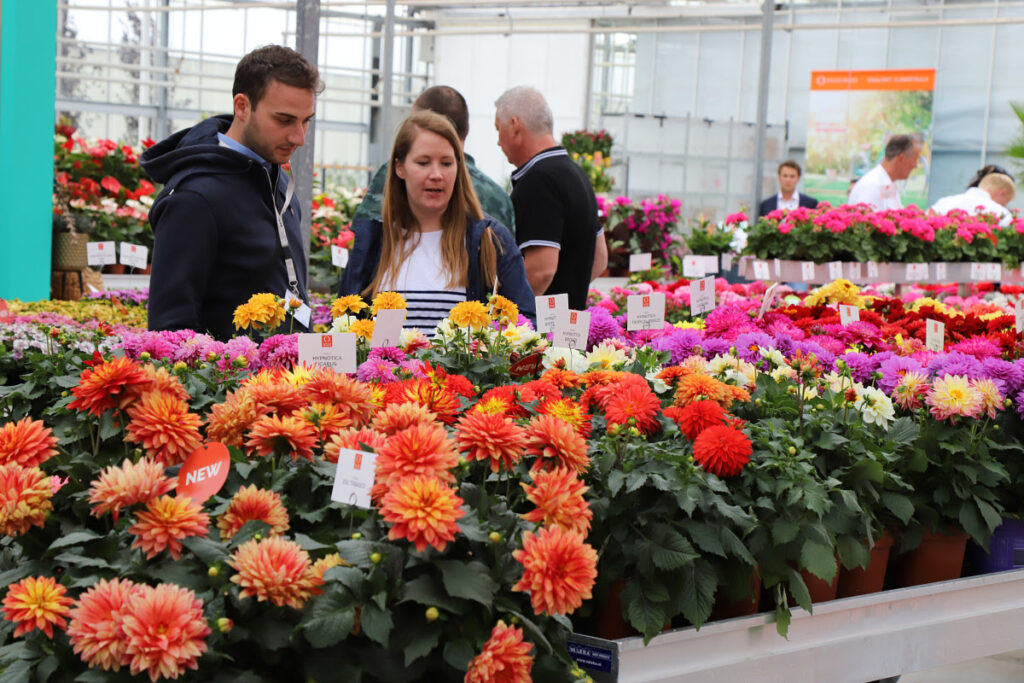Welcome to the first E Bulletin of 2022. There is a real sense of optimism and with many events being being scheduled and restrictions lifted. It is a welcome change with out doubt.
Other concerns haven’t gone away; high input costs and labour shortages have become a widespread issue. It is reported that supply for the first six months of the year will be tightest with some recommending pushing out some purchases, limiting advance purchases until the second half of the year.
Normally IPM Essen would highlight a lot of opportunities and new market trends. In the absence of the event the organisers have issued a review of 2021 and some market insight for 2022. Its review looks mostly across the Benelux countries but does reflect similarity with Ireland. It reports that price increases of 5% for bedding and pot plants had little resistance from customers “When looking at an average of all product ranges, a price increase of 13 cents per pot was observed. Therefore, in 2021, the average price per bedding plant or balcony plant was €2.62 rather than €2.49.” Yet the report highlights the increased cost of trade with 33% of the horticultural businesses achieving significantly lower profits than in previous years despite the “explosion in sales”.
Some thoughts from IPM Essen on what lies ahead for 2022
- In general, 2021 has shown us that the top sellers from before the pandemic will continue to experience increased demand and their popularity is likely to increase even further in 2022. According to the findings from this year, flowering perennials, bedding and balcony plants, herbs, vegetable plants and snack garden plants will continue to perform particularly well.
- One thing that is noteworthy is the fact that larger plants are in particularly high demand. For example, experts have observed that consumers are now more likely to want lavender in a 2-litre pot rather than in a small T12 pot.
- “Ready to enjoy” is an increasingly important topic in the sector. In 2021, garden centres noticed a significant increase in sales of items that could be given as gifts or used for celebrations. In terms of celebrations, the items tended to be in a small container but with elaborate flowers and plant decorations. This observation was also confirmed by Veiling Rhein-Maas, who reported that the trend towards high-quality trays and arrangements would continue to strengthen in the third quarter of 2021.
- In addition, the trend towards easy-care plants increased yet again in 2021. The topic of insect-friendly plants also gained momentum as part of the coronavirus pandemic. This trend is expected to increase further in 2022 due to the wide public discussions surrounding climate protection. In general, consumers appear to be shopping more consciously. Sustainable and individual products are increasingly in demand. According to experts, even over 50s are sensitive to the topics of sustainability and organic products and are increasingly interested in such products.
- The sparing use of natural resources during the production of flowers and plants has been an important factor for several years and continued to gain in importance in 2021. Reducing the use of peat and plastic is an important topic for all gardeners.

Growing Media
Three key activities have taken place in the last month;
- the working group report was published,
- the Government’s actions in response to this report were announced and,
- a guidance document was issued in relation to peat extraction.
The report by the Chair of the Working Group on the use of peat moss in the horticulture industry is now available. It sets out fifteen key actions required to support the industry during its transition to eliminating peat use.
A Joint Series of Actions was developed in response by the Department of Agriculture, working in collaboration with the Departments of Environment, Climate and Communication, and Housing, Local Government and Heritage. The Irish Hardy Nursery Stock Association (IHNSA) and Growing Media Ireland (GMI) have voiced their concern and disappointment with the governments response. John Neenan chair of GMI issued a statement voicing their “outrage” with the action plan as it dismissed the reports recommendations and Neenan stated “In the Government’s ‘series of actions’ there is no reference to the transition to alternatives by 2035 as recommended in the working group report”. In a statement IFA Horticulture Chairman Paul Brophy said that the Action Plan is extremely disappointing for growers. “The final report is outstanding since October 20th and it’s contradictory that an Action Plan does not conform with the report’s recommendations.” The statement went on to say “The Plan will do nothing other than lead to the demise of the sector. It doesn’t indicate how the current producers of the key raw material can become fully compliant and continue to service the industry needs”.
The actions set out as by the Government Departments are:
Short Term
1. The Department of Agriculture will commission an independent expert to work with all suppliers to ascertain the level of horticultural peat stocks available to growers. The current understanding is that there is sufficient stock available to supply growers for the coming period. Bord na Mona has indicated that it may have up to 2,000 tonnes of high grade horticultural peat available which it is willing to make available on commercial terms.
2. The independent expert will also work with Bord na Móna, other suppliers and growers to ascertain whether or not any hobby or other peat on their estate would be of interest or value to growers. Such peat might be suitable for mixing by current suppliers to produce a growing medium of value to growers. Should that be the case, Bord na Mona is willing to supply it.
3. The Department of Environment, Climate and Communications, in partnership with the National Parks and Wildlife Service, to publish expert guidance on the regulation of peat extraction in Ireland.
Medium Term
4. The Department of Agriculture, Food and the Marine will commission an expert(s) on planning to provide free advice to those wishing to achieve regulatory compliance for extraction of horticultural peat on sub-30 hectare bogs for supply to the domestic horticulture industry. Bord na Móna has given an assurance to make available the use of its equipment to mix such peat, should it become available.
Longer Term
5. DAFM will continue to support and facilitate research in the development of alternatives to peat for horticulture. It should be noted that €1.69m was recently awarded to Teagasc for research into utilising organic bio-resources and novel technologies to develop specifically designed and sustainable peat replacements.
6. The National Parks and Wildlife Service has committed to the provision of assistance and support on the rehabilitation and restoration of bogs after short term legally compliant extraction has concluded.
Additionally there has been a guidance document issued “The regulatory framework applying to peat extraction”.
Plant protection products
Updates for 2022 have yet to be released. The main loss I am aware of for 2022 will be Systhane and Indoxacarb.
Systhane (Myclobutanil) is now in its use up phase – ending 30/11/22.
Indoxacarb was voted for non renewal by EU in late 2021. Steward is the main trade name it is sold under in Ireland. It is used for the control of caterpillars and other insect pests. It is likely it will be withdrawn for sale by mid March and will have a use up period until mid September – see PRCD web site for details.

Soil Testing and Field Nutrition
Soil testing should be completed as soon as possible if not already done. Lime and fertiliser application are best based on good data, matching the pH and soil available nutrients to the plants requirements. Organic sources of nutrients can be cost effective and increase soil organic matter which has multiple benefits.
Addressing pH takes time but pays dividends in increased availability of nutrients and improved plant growth. Finer lime particles will give a faster impact on soil pH and are recommended for this time of year. Coarser lime is slower acting and will take a number of years to impact pH. See Teagasc guidance on pH and Lime.
Nitrogen is highly mobile in soil and application should be based on total demand. This can come from natural nitrogen gas fixation by bacteria in some plant roots, organic matter, organic sources and mineral fertilisers. Nitrogen demands for trees and shrubs can vary between 50 and 80 units per hectare compared to up to 150 for grassland. N supplies need to be available prior to flushes of growth in spring and mid summer. Any deficiencies at these times will limit plant growth. Nitrogen sources such as slurry can react with lime to increase the harmful loss of N to the atmosphere.
P and K levels are slower to increase with fertiliser input and application of organic matter. Growers should always apply fertiliser based on soil or foliage analysis. As costs of mineral fertilisers have soared it is essential that growers limit the wasted product. Optimising pH with lime will help with nutrient uptake in particular Phosphates.
Additionally soil health can be considered. Stimulating activity of soil micro flora can help increase the availability of some nutrients. SOILCOM an EU funded research project has demonstrated the impacts of compost additions to field grown Portuguese Laurel. In a field scale trial in Netherlands, in the first year less growth was seen in the crops grown with compost. However report states “The second year, however, the plant growth of the treated plants was better: more vitality and longer shoots. By measuring the soil life, there was an increase in fungi and protozoa and a also an increase in the diversity of microbes in the soil.”. See trial details here.
Winter Weed Control – Reminder
With fewer selective weed control options it is important to maximise the efficiency of weed control options. A winter clean up and longer lasting controls applied in succession will give best weed control and plant growth.
- Seed beds can use Stomp Aqua, Centium/Sitaki, Mitron 700.
- Established plants options include: Sencorex Flow, Stomp Aqua, Venzar 500 SC, Sunfire, Emerger and Proman. Beetup Flow/Betanal flow (Phenmedipham) may offer a some increased weed control spectrum also
- Additional winter controls Wing P, Kerb and Flexidor should be considered.
Options under protection are very limited.
- Seedling and Bulbs under protection can include: PDM, Summimax,
- Ornamental under protection include: Flexidor, Betanal Flow, Sencorex Flow,
See details for control programmes on our weed control webinar and pdf.

Flower Trials Teagasc Tour June 14-16th
The Flower Trials offers a great opportunity to see the latest innovations in plant breeding and marketing. Leading young plant producers will open their doors and invite growers and customers to meet the teams. Bedding, pot plant, cut flowers, orchid and rose plant and seed producers will be open to the trade. It is planned that over three days we will visit a range of companies and some productions sites. Key companies include: Florensis, Volmary, Van der Haak, Schneider, Pan American/Ball Colegrave, Benary, Syngenta Flowers, Beekenkamp, Selecta One, Danziger and Dummen Orange.
If you are interested in joining the group please contact me for the full itinerary.
Health and safety – Sprayer testing reminder of requirements
Testing of sprayers is again back in focus. Article 8 of European Commission directive 2009/128/EC states “The The interval between inspections shall not exceed five years until 2020 and shall not exceed three years thereafter.”
For nurseries and farmers this means that any orchard or blast sprayer, or sprayers with a boom greater than 3m which were tested during or prior to 2016, is now due another test. The grower can find out when the test is due by looking at the sticker placed on the sprayer at the time of initial test, see example below where the equipment tested would have punched a hole showing the month and year when the test took place.
Visit the current list of DAFM approved Equipment Inspectors


Dates For Your diary
- February 21st Teagasc Webinar – IPM control of pests – David Davidson Koppert
- February 22nd AFF Heat Pump Work Shop Teagasc, Ashtown
- February 26th GLDA online seminar
- March 23rd Teagasc Biomethane Workshop Teagasc Ashtown
- April 29th AFF Biomass boiler and Solar PV Work Shop Teagasc Ashtown
- June 2nd – 6th Bord Bia Bloom 2022
- June 14-15th IPM Essen Summer Edition
- June 14-17th Flower Trials, Netherlands








